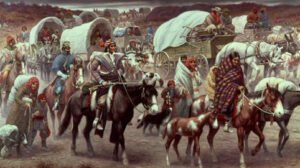
Credit: The Granger Collection, New York
Tears.
Among the most detrimental policies for Native Americans in U.S. history began in the early 1800s. By 1830, Andrew Jackson had signed the Indian Removal Act, which authorized a plan to appropriate Indian land, a practice that had been followed since Europeans arrived in North America. The idea of segregating Indians onto poor land was first suggested by Thomas Jefferson after the Louisiana Purchase. Thus began a system of appropriating Indian land and undermining Indian culture that has been expressed throughout U.S. history. Although many Indians had taken on European cultural traits, including religious conversion and worked their land using white methods, they were still considered incapable of assimilating into white society. Despite continuing efforts by Europeans to convert Indians to Christianity, they continued to be viewed as heathens in both popular cultural and society.
- In 1803, the Lewis and Clark expedition set off down the Ohio River, beginning three-year journey to the West.
- In 1808, American Indian Pocahontas was depicted in the play The Indian Princess or La Belle Sauvage. That same year, the Osage, a Sioux tribe, signed a treaty ceding their lands in what is now Missouri and Arkansas.
- Between 1809-1811, Shawnee Indian leader Tecumseh led a group of Indians against Andrew Jackson’s U.S. forces who were intent on forcing Indian tribes to give up their land. In the end, thousands of Cherokees, Chickasaws, Choctaws, Creeks and Seminoles were forced to move west of the Mississippi
River. - In the War of 1812 between the U.S. and Britain, a faction of the Creek Indians sided with the British and fought against Andrew Jackson and his soldiers in the Battle of New Orleans. Some slaves, who had been promised manumission by both the British and the U.S. if they agreed to fight, were freed. Others who fought with the British managed to flee to the Caribbean.
- After the War of 1812, a faction of the Creek Indians known as the Red Sticks (because of the color of their war clubs) attacked Fort Mims in the Mississippi Territory on August 30, 1813, killing between 300 and 400 people. Andrew Jackson avenged the attack in the Battle of Horseshoe Bend on March 27, 1814, when the Red Sticks were trapped and slaughtered, ending the Creek War. The Creek lost 20 million acres of land, half of all the land they had claimed. Fugitive slaves and Seminole Indians joined together to fight Andrew Jackson’s forces in the First Seminole War between 1817 and 1819. The U.S eventually annexed east Florida, which had served as a refuge for runaways.
- The Santa Fe Trail opened in 1821.
- In 1828, the Cherokee Phoenix was published, the first American newspaper in a Native language.
The Indian Removal Act passed by Congress in 1830 under Andrew Jackson’s urging was designed to appease white settlers who wanted the 25 million acres of land in the southeast owned by Indians. The removal involved all of the five “civilized tribes” as they were called-Creek, Cherokee, Choctaw, Chickasaw and some Seminoles-who had previously owned land and were working their farms much like white men.

Source: Official White House portrait, The Presidents of The Unites States
“John Marshall has made his decision, now let him enforce it!”
– Andrew Jackson
Population growth and the discovery of gold on Cherokee lands in the South increased pressure on tribal lands, and made the Indian Removal Act especially popular there. In 1832, however, the U.S. Supreme Court ruled in Worcester v. Georgia that Georgia could not impose its laws on Cherokee tribal lands. It is questionable whether Andrew Jackson’s oft-quoted reaction to the decision, “John Marshall has made his decision, now let him enforce it!” is historically accurate, but it is untrue that he actually defied the Supreme Court. Instead, he used the Georgia dispute to pressure Cherokee leaders into signing a removal treaty. Although the treaty was rejected by most Cherokees, a faction led by Jackson’s longtime ally Major Ridge negotiated the Treaty of New Echota with Jackson’s administration. Jackson’s successor, Martin Van Buren, strictly enforced the terms of the treaty, resulting in ‘The Trail of Tears.”




